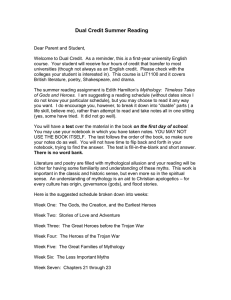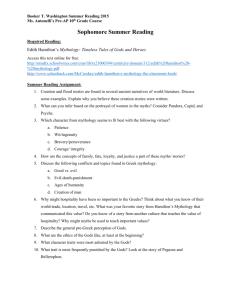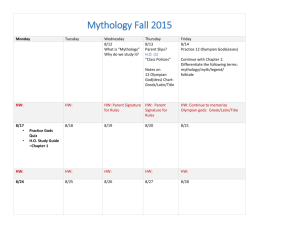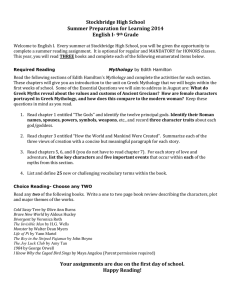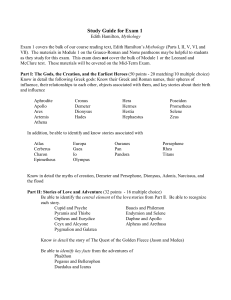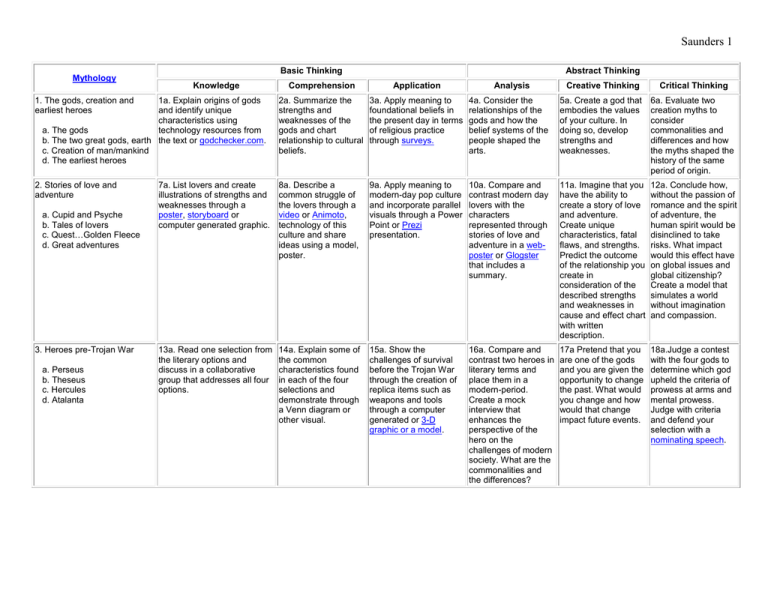
Saunders 1
Mythology
Basic Thinking
Knowledge
Application
2a. Summarize the
strengths and
weaknesses of the
gods and chart
relationship to cultural
beliefs.
3a. Apply meaning to
foundational beliefs in
the present day in terms
of religious practice
through surveys.
7a. List lovers and create
illustrations of strengths and
weaknesses through a
poster, storyboard or
computer generated graphic.
8a. Describe a
common struggle of
the lovers through a
video or Animoto,
technology of this
culture and share
ideas using a model,
poster.
13a. Read one selection from
the literary options and
discuss in a collaborative
group that addresses all four
options.
14a. Explain some of
the common
characteristics found
in each of the four
selections and
demonstrate through
a Venn diagram or
other visual.
1. The gods, creation and
earliest heroes
1a. Explain origins of gods
and identify unique
characteristics using
a. The gods
technology resources from
b. The two great gods, earth the text or godchecker.com.
c. Creation of man/mankind
d. The earliest heroes
2. Stories of love and
adventure
a. Cupid and Psyche
b. Tales of lovers
c. Quest…Golden Fleece
d. Great adventures
3. Heroes pre-Trojan War
a. Perseus
b. Theseus
c. Hercules
d. Atalanta
Abstract Thinking
Comprehension
Analysis
Creative Thinking
Critical Thinking
4a. Consider the
relationships of the
gods and how the
belief systems of the
people shaped the
arts.
5a. Create a god that
embodies the values
of your culture. In
doing so, develop
strengths and
weaknesses.
6a. Evaluate two
creation myths to
consider
commonalities and
differences and how
the myths shaped the
history of the same
period of origin.
9a. Apply meaning to
modern-day pop culture
and incorporate parallel
visuals through a Power
Point or Prezi
presentation.
10a. Compare and
contrast modern day
lovers with the
characters
represented through
stories of love and
adventure in a webposter or Glogster
that includes a
summary.
11a. Imagine that you
have the ability to
create a story of love
and adventure.
Create unique
characteristics, fatal
flaws, and strengths.
Predict the outcome
of the relationship you
create in
consideration of the
described strengths
and weaknesses in
cause and effect chart
with written
description.
12a. Conclude how,
without the passion of
romance and the spirit
of adventure, the
human spirit would be
disinclined to take
risks. What impact
would this effect have
on global issues and
global citizenship?
Create a model that
simulates a world
without imagination
and compassion.
15a. Show the
challenges of survival
before the Trojan War
through the creation of
replica items such as
weapons and tools
through a computer
generated or 3-D
graphic or a model.
16a. Compare and
contrast two heroes in
literary terms and
place them in a
modern-period.
Create a mock
interview that
enhances the
perspective of the
hero on the
challenges of modern
society. What are the
commonalities and
the differences?
17a Pretend that you
are one of the gods
and you are given the
opportunity to change
the past. What would
you change and how
would that change
impact future events.
18a.Judge a contest
with the four gods to
determine which god
upheld the criteria of
prowess at arms and
mental prowess.
Judge with criteria
and defend your
selection with a
nominating speech.
Saunders 2
4. Heroes of Trojan War
19a. Present artifacts from
the time period of the Trojan
war and relate their
importance in terms of
survival.
20a. Investigate
information about the
Trojan war with focus
on one area;
summarize the impact
of hero’s actions on
the events
surrounding the war.
21a. Collect statistical
data and visual
representations of the
geographical area of the
Trojan War. Reveal this
information in a video or
Animoto set to music
and pictures.
22a. Specify
similarities and
differences between a
modern-day hero and
one from the list.
Narrate a battle
between the two and
indicate the outcome
in a storyboard.
23a. Create an
imaginary god that
alters the outcome of
the war. Predict how it
would impact Greek
culture and history
through a mock
survey presentation to
reveal impact.
24a. Decide which of
the four items held the
most importance in
literature and support
your claim through a
newscast and
editorial.
5. Great Families
a. House of Atreus
b. Royal House of Thebes
c. Royal House of Athens
d. Select one other
25a. Describe one of the four
great families and the
complexity of the family tree.
Use a hand-drawn or
computer generated
genealogy chart to identify
relationships.
26a. Explain the
challenges of one
house and role-play
characters with
biographies in a
collaborative group.
Use learnergenerated questions
to balance the
discussion in the
intended spirit of the
mythological period.
27a. Model one of the
three families in a
modern day struggle as
it would appear on a
reality television show.
Present skit to class.
28a. Compare and
contrast two families
in the spirit of Romeo
and Juliet or West
Side Story. Consider
the challenges of a
romance across the
two families and the
cultural similarities
and differences.
Represent your
findings in an
Extranormal video.
29a. Predict how one
great family would
react to modern
culture. Take a one
event in the life of the
family and predict
how the same event
would play out in
modern times. Create
a poster, e-poster, or
Glogster document to
represent the types of
movies, stores,
television programs
and activities that the
family would engage
in the 21st century.
30a. Conclude what
family members
would function in
today’s lawful society
and those that would
be admonished for
their behavior.
Synthesize the
common
characteristics of lawabiding citizens in
modern culture with
the one of the great
families and evaluate
the universal traits
that they embody.
6. Mythology of the Norsemen
a. Norse Mythology
b. Signy and Sigurd
c. Norse Gods
d. The Creation
e. Norse Wisdom
31a. Describe Norse
Mythology and use pictures
and words as flash cards or
design digital cards to
identify.
32a. Explain the
diversity of gods in
mythology, creating a
list of identifiers.
Create one Wordle for
commonalities and
one Wordle for
differences.
33a. Embody the spirit
of one of the gods in
response to an
improvisational prompt
from peers.
34a. Compare and
contrast the Norse
creation story with
that of one other in
the book. Consider
cultural commonalities
and differences.
Create your own myth
using the information
provided.
Code:trinityhigh
35a. Predict the
outcome of a battle
with one Norse god
and another of your
choosing from Edith
Hamilton’s Mythology.
Use the PP or Prezi to
demonstrate the
battle and create two
endings. Allow the
audience to choose
the ending. Survey
the audience on
Surveymonkey.com
and embed on your
wiki space.
36a. Draw a
conclusion as to how
the mythology of the
Norsemen is a lesserknown myth and
relate its importance
to both modern
culture and the
present-day culture of
the same region.
a. Paris
b. Fall of Troy
c. Odysseus
d. Aeneas
CSM ® Unit Matrix; Copyright © 1985-2005, by J. Curry and J. Samara; All Rights Reserved
Saunders 3
Kathleen Saunders
TED 622
Dr. Faircloth
31 March 2011
Reflection and Research
This lesson is a modification from an Advanced Placement English Literature and Composition lesson on mythology. The text selected is
Edith Hamilton’s Mythology, a staple in exploring mythology. I have always struggled with engaging the AP learner in mythology while recognizing
its importance in terms of literary allusion and learner reading experience. This study of mythology is offered as an in-depth view of the foundational
studies of mythology in freshman and junior year. The lesson is a timely complement to the study of Sophocles’ Antigone and Shakespeare’s Hamlet.
Where I have always struggled is in the balance of time with the overwhelming nature of the unit and the sheer quantity of material. As part of this
activity, I decided to use this unit to explore mythology and apply this same knowledge to enhance appreciation of other literature. In a collaborative
effort with Tracy Schill, a discussion occurred about the application of the chart for higher level learners. In an attempt to encourage abstract
reasoning and higher order thinking skills, the decision was made to require students to select two from the abstract level with the option of selecting
two others from either the upper (abstract) or lower (basic) ranges presented. Furthermore, in the spirit of differentiation, students are also given the
option to negotiate parallel activities for which they are interested. The chart supports options that foster 21st century learners through technology,
global awareness, and higher order thinking skills. The premise for using links as options, and not mandates, supports the claim that the learner needs
to engage in technology that supports a public forum such as publishing, creating, and sharing learning experiences (Churches, 2008). Students are
able to select areas of interest and teach the same to the class. The exploration of material culminates in student opportunities to share findings and
Saunders 4
teach others. The presentation of findings will foster the concept of applying learning in a format that is relevant and authentic in the world of the 21st
century learner.
Advanced learners do not always present themselves as high-functioning students (Winebrenner, S, 2001, pps.9-30). According to Spencer
Kagan, “We, as educators today, have the unprecedented job of preparing pupils to participate in a world we can only dimly imagine” (North
Carolina Teacher Academy, 2007). Teachers are expected to take students on a journey of discovery through organizing, applying, and analyzing
relationships through information. The format of the learning environment can dictate the interest level of the learner; as such, the teacher must
relinquish control of the process to the learner. The advanced learner may be easily hidden as the silent or apathetic learner. The lesson, through use
of the Curry-Samara Chart, facilitates choice and control through higher order thinking skills. Through generating and integrating, students are selfdirected through questioning and examining information to create a unique perspective. This is much like Bloom's synthesis but it also involves restructuring through an active process on the part of the learner. The final step, evaluating, is student driven and creates a forged perspective through
prior, accumulated, and synthesized information. The options allow the learner to individualize the learning process. A key element in 21st century
success for learners is in the ability to collaborate with others; this is a challenge at times with the advanced learner. While the learner is advanced,
internal struggles, such as the drive for perfection, may preclude the ability to perceive value in cooperative learning. The struggle is the learning
process for many advanced learners, particularly the perfectionists, and control and choice may offer a variety of venues for learning that will be less
restrictive. As such, the activity forges team work and collaboration, while avoiding making the individual a tutor, and engages the learner in the
spirit of diversity (Winebrenner, S, 2001, pps.9-15), (Gray, 2002, p. 187).
Ultimately, enrichment activities that encourage innovation and exploration in a non-restrictive environment support the development of the
advanced learner. Through a diverse set of options in a format that nurtures the promotion of creativity, critical thinking, inquiry and problemsolving, the Curry-Samara chart supports conceptual learning. As the individual groups self-direct their learning process toward mastery, others are
Saunders 5
able to benefit in their diverse expression and thereby raise global awareness of others and other cultures (Renzulli Learning, 2011). As always, I
look forward to the direction in which my students will lead the learning process. The Curry-Samara Chart embraces opportunity for advanced
learners to flourish.
Saunders 6
References
Churches, A. (2008, April 1). Bloom's Taxonomy Blooms Digitally. Retrieved March 10, 2011,
from Tech & Learning: http://www.techlearning.com/article/8670
Gray, K. C. (2002). Multiple Intelligences Meet Bloom's Taxonomy. Kappa Delta Pi , 184-187.
North Carolina Teacher Academy. (2007). Differentiating Instruction with Multiple Intelligences. Morrisville, NC.
Renzulli Learning. (2011). Retrieved March 31, 2011, from Curry/Samara Model; Curriculum,Instruction, & Assessment;A Tool to Transfer
Scientific Research on Authentic Achievement to the Classroom: http://www.roe11.k12.il.us/GES%20Stuff/Day%205/Models%20Packet.pdf
Winebrenner,S. (2001). Characteristics of Gifted Students. Teaching Gifted Kids in the Regular Classroom. Minneapolis: Free Spirit Publishing,
Inc., 9-30.

